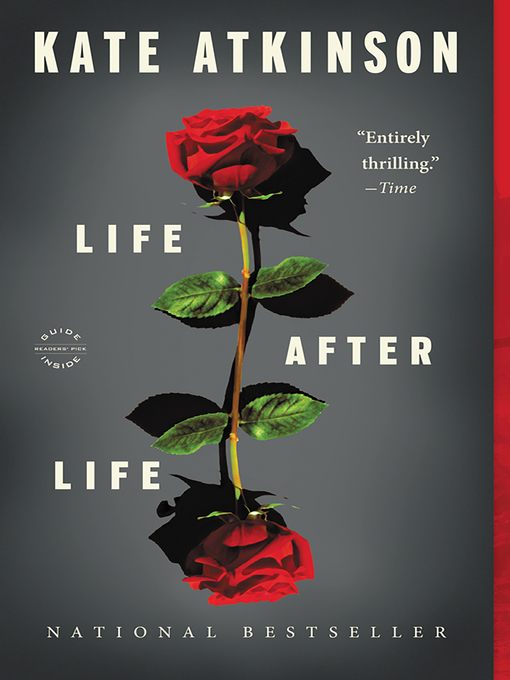
Life After Life
Todd Family Series, Book 1
فرمت کتاب
ebook
تاریخ انتشار
2013
Lexile Score
970
Reading Level
5-7
نویسنده
Kate Atkinsonشابک
9780316230803
کتاب های مرتبط
- اطلاعات
- نقد و بررسی
- دیدگاه کاربران
نقد و بررسی

Starred review from January 21, 2013
Atkinson’s new novel (after Started Early, Took My Dog) opens twice: first in Germany in 1930 with an English woman taking a shot at Hitler, then in England in 1910 when a baby arrives, stillborn. And then it opens again: still in 1910, still in England, but this time the baby lives. That baby is Ursula Todd, and as she grows up, she dies and lives repeatedly. Watching Atkinson bring Ursula into the world yet again initially feels like a not terribly interesting trick: we know authors have the power of life and death. But as Ursula and the century age, and war and epidemic and war come again, the fact of death, of “darkness,” as Atkinson calls it, falling on cities and people—now Ursula, now someone else, now Ursula again—turns out to be central. At heart this is a war story; half the book is given over to Ursula’s activities during WWII, and in its focus on the women and civilians usually overlooked or downplayed, it gives the Blitz its full measure of terror. By the end, which takes us back to that moment in 1930 and beyond, it’s clear that Atkinson’s not playing tricks; rather, through Ursula’s many lives and the accretion of what T.S. Eliot called “visions and revisions,” she’s found an inventive way to make both the war’s toll and the pull of alternate history, of darkness avoided or diminished, fresh. Agent: Kim Witherspoon, Inkwell Management.

February 1, 2013
If you could travel back in time and kill Hitler, would you? Of course you would. Atkinson's (Started Early, Took My Dog, 2011, etc.) latest opens with that conceit, a hoary what-if of college dorm discussions and, for that matter, of other published yarns (including one, mutatis mutandis, by no less an eminence than George Steiner). But Atkinson isn't being lazy, not in the least: Her protagonist's encounter with der Fuhrer is just one of several possible futures. Call it a more learned version of Groundhog Day, but that character can die at birth, or she can flourish and blossom; she can be wealthy, or she can be a fugitive; she can be the victim of rape, or she can choose her sexual destiny. All these possibilities arise, and all take the story in different directions, as if to say: We scarcely know ourselves, so what do we know of the lives of those who came before us, including our own parents and--in this instance--our unconventional grandmother? And all these possibilities sometimes entwine, near to the point of confusion. In one moment, for example, the conversation turns to a child who has died; reminds Ursula, our heroine, "Your daughter....She fell in the fire," an event the child's poor mother gainsays: " 'I only ever had Derek, ' she concluded firmly." Ah, but there's the rub with alternate realities, all of which, Atkinson suggests, can be folded up into the same life so that all are equally real. Besides, it affords several opportunities to do old Adolf in, what with his "funny little flap of the hand backward so that he looked as if he were cupping his ear to hear them better" and all. Provocative, entertaining and beautifully written. It's not quite the tour de force that her Case Histories (2004) was, but this latest affords the happy sight of seeing Atkinson stretch out into speculative territory again.
COPYRIGHT(2013) Kirkus Reviews, ALL RIGHTS RESERVED.

November 15, 2012
Atkinson's debut, Behind the Scenes at the Museum, won the Whitbread Book of the Year Award; best sellers like Started Early, Took My Dog give a whole new meaning to the idea of smart suspense. Here, on a cold, snow-blown night in 1910, Ursula Todd is born to an English banker and his wife and promptly dies. But wait, Ursula Todd is born in 1910 and lives, growing, living, dying, and living over and over again as the events move toward World War II. Perhaps those multiple lives could allow her to redirect a fraught and dangerous century.
Copyright 2012 Library Journal, LLC Used with permission.

Starred review from February 15, 2013
In a radical departure from her Jackson Brodie mystery series, Atkinson delivers a wildly inventive novel about Ursula Todd, born in 1910 and doomed to die and be reborn over and over again. She drowns, falls off a roof, and is beaten to death by an abusive husband but is always reborn back into the same loving family, sometimes with the knowledge that allows her to escape past poor decisions, sometimes not. As Atkinson subtly delineates all the pathways a life or a country might take, she also delivers a harrowing set piece on the Blitz as Ursula, working as a warden on a rescue team, encounters horrifying tableaux encompassing mangled bodies and whole families covered in ash, preserved just like the victims of Pompeii. Alternately mournful and celebratory, deeply empathic and scathingly funny, Atkinson shows what it is like to face the horrors of war and yet still find the determination to go on, with her wholly British characters often reducing the Third Reich to a fuss. From her deeply human characters to her comical dialogue to her meticulous plotting, Atkinson is working at the very top of her game. An audacious, thought-provoking novel from one of our most talented writers. HIGH-DEMAND BACKSTORY: Atkinson's publisher is pulling out all the stops in marketing her latest, which will no doubt draw in many new readers in addition to her Jackson Brodie fans.(Reprinted with permission of Booklist, copyright 2013, American Library Association.)

























دیدگاه کاربران